Hello students and welcome to the last Chapter of Class 6! We have supplemented our solutions to NCERT Class 6 Science Chapter 12 Beyond Earth with extra questions of various formats, keeping in mind students’ and NCERT’s new requirements. The extra questions include very short answer type, short-answer type, long-answer type, fill in the blanks and match and pair type questions and provide a wealth of practice. We suggest you study them in detail as they will prepare you well for your exams.
Solutions to ‘Let us enhance our learning’ (Page No 249) of NCERT Class 6 Science Curiosity Chapter 12 Beyond Earth
1. Match the column:
| Column I | Column II |
| (i) Satellite of Earth | (a) Orion |
| (ii) Red planet | (b) Venus |
| (iii) Constellation | (c) Mars |
| (iv) Planet which is commonly called an evening star | (d) Moon |
Solution:
| Column I | Column II |
| (i) Satellite of Earth | (d) Moon |
| (ii) Red planet | (c) Mars |
| (iii) Constellation | (a) Orion |
| (iv) Planet which is commonly called an evening star | (b) Venus |
2 (i) Solve the following riddle.
My first alphabet is in MAN but not in CAN
My second alphabet is in ACE and also in FAN
My third alphabet is in RAT and not in CAT
My fourth alphabet is in SUN but not in FUN
I am a planet that moves around the Sun.
(ii) Make two similar riddles by yourself.
Solution:
(i) The riddle is solved below:
My first alphabet is in MAN but not in CAN M
My second alphabet is in ACE and also in FAN A
My third alphabet is in RAT and not in CAT R
My fourth alphabet is in SUN but not in FUN S
I am a planet that moves around the Sun. MARS
(ii) Two similar riddles are given below:
First Riddle:
My first alphabet is in MEN but not in MAN E
My second alphabet is in PAN but not in PEN A
My third alphabet is in CAR but not in CAT R
My fourth alphabet is in TEA but not in PEA T
My fifth alphabet is in HORSE and also in HUT H
I am a planet that appears blue from outer space EARTH
Second Riddle:
My first alphabet is in ON and also in OFF O
My second alphabet is in CAR but not in CAN R
My third alphabet is the same as the first alphabet I
My fourth alphabet is in NEST but not in PEST N
I am a constellation. ORION
3. Which of the following is not a member of our Solar System?
(i) Sirius (ii) Comets
(iii) Asteroids (iv) Pluto
Solution:
(i) Sirius
4. Which of the following is not a planet of the Sun?
(i) Jupiter (ii) Pluto
(iii) Neptune (iv) Saturn
Solution:
(ii) Pluto
5. Which is the brighter star, the Pole Star or Sirius?
Solution:
Sirius is the brighter star, but the Pole star is not very bright.
6. An artist’s representation of the Solar System is given in Fig. 12.12. Is the order of the planets correct? If not, write the correct order in the boxes in the figure.
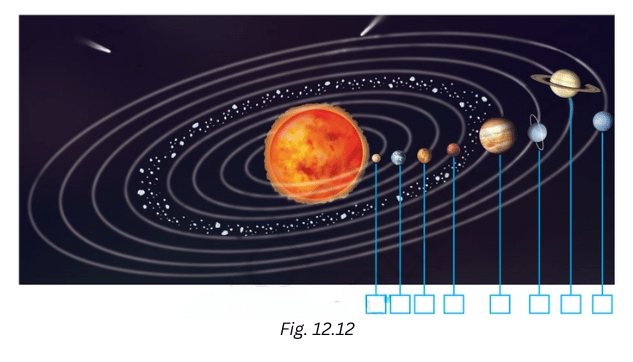
Solution:
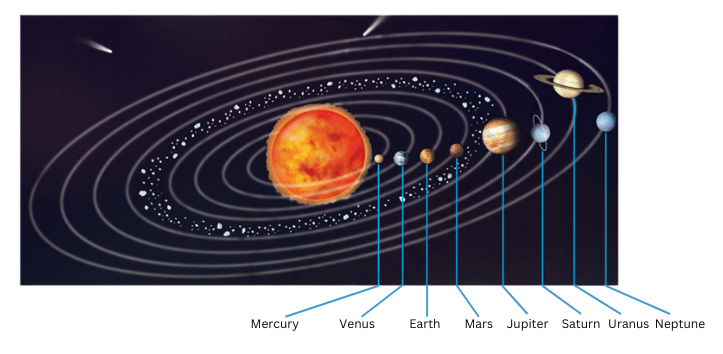
7. A portion of night sky with stars is shown in Fig. 12.13. Look carefully and identify the groups of stars that form the patterns—the Big Dipper and the Little Dipper. Draw lines to connect the stars for these patterns and label them. Also, identify and label the Pole Star. You may refer to Fig. 12.4 for help.
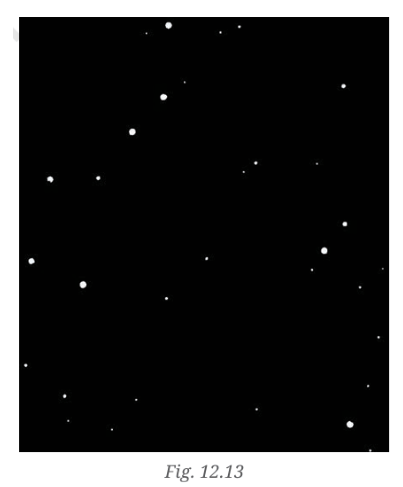
Solution:
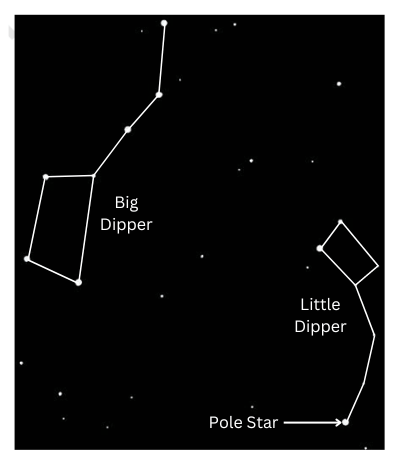
8. A portion of the night sky is shown in Fig. 12.14. Draw lines to connect the stars for Orion and label the star Sirius. You may refer to Fig. 12.3.
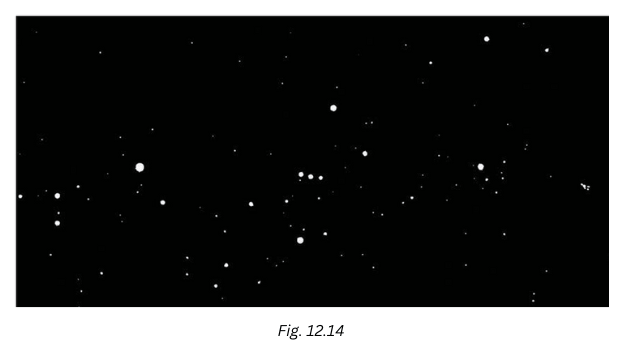
Solution:
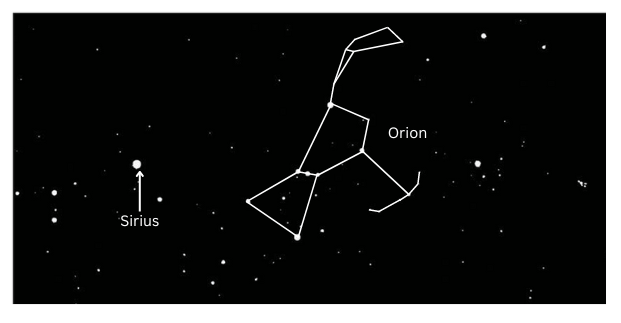
9. You can see stars fading away at dawn and appearing at dusk. During the day we do not see the stars. Explain why.
Solution:
During the day we do not see the stars because of the bright light of the sun. During the day the sun shines with such intensity that the light from the sun overwhelms the light from the stars.
At dawn, as the Sun rises, its light gradually increases, causing the stars to fade from view. In contrast, since the Sun’s light fades at dusk, the light of the stars becomes more prominent.
10. During a clear night, try to observe the Big Dipper 3–4 times at an interval of 2 to 3 hours. Also try to locate the Pole Star each time. Does the Big Dipper appear to move? Draw a rough sketch to illustrate this, mentioning the time in each case.
Solution:
The Big Dipper moves in an anticlockwise direction with the Pole Star at its centre. Join the two pointer stars of the Big Dipper with the Pole Star. This forms a line which acts as the hour hand of an imaginary clock. You can tell the time using the positions of the Big Dipper with respect to the Pole Star. The positions of the Big Dipper at 9 pm, 12 am and 3 am are shown below:
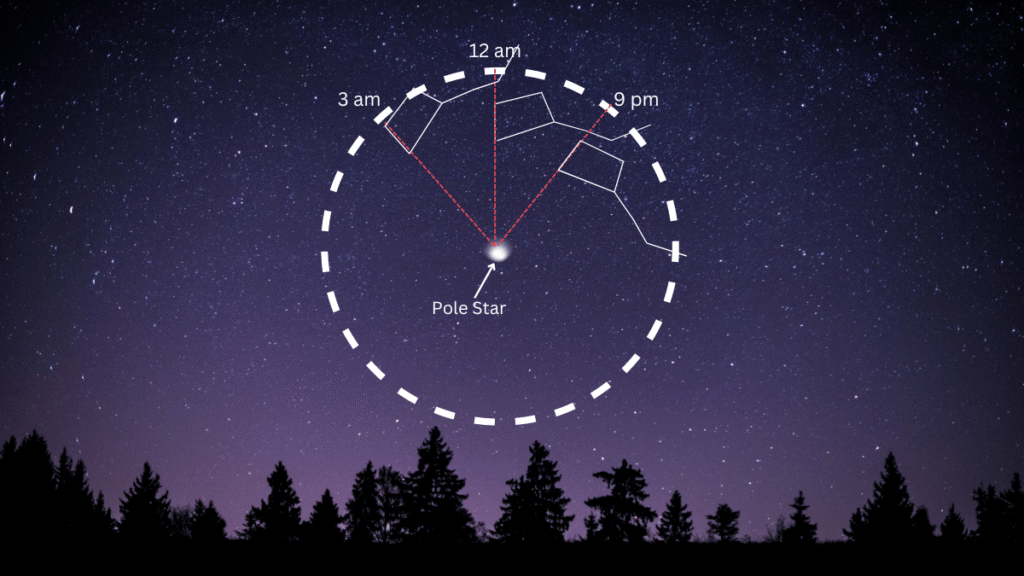
11. Think about the night sky and write a poem or a story on it.
Solution:
Gifts of the Night Sky:
On the balcony of a little house, nestled between rolling hills and a vast forest, sat a little girl called Aisha. Her grandmother was telling her fascinating tales about the night sky. Even Aisha herself found peace and tranquillity gazing up at the sky shimmering with stars. She wondered how far away they were and if there was life beyond them.
Again tonight she found herself stargazing. She was awestruck. Her expression said it all. Her grandmother smiled at her and said, “The night sky is a gift. It offers us many benefits, more than just beauty.”
She told Aisha of times long gone when compasses and other modern navigational instruments were yet to be invented. Sailors would use stars such as the Pole Star to find their bearings in the middle of the vast ocean. She pointed to a distant round object in the sky and said, “Aisha, look! The Pole Star always points north, helping people find their way! Is it not amazing?”
Aisha had learnt about constellations in class, but this was the first time she saw them in real life. Aisha’s grandmother told her of the myths and legends surrounding the different constellations in the night sky. One by one she pointed out the Orion the Hunter, the Great Bear, and the Seven Sisters and narrated to her the legends associated with them. She narrated how long ago, in ancient Greece, there were seven beautiful sisters who were being relentlessly pursued by the hunter Orion. To protect them, the Greek God Zeus transformed the sisters into a cluster of stars and tucked them away safely in the night sky. Today, the Seven Sisters shine brightly, forever out of Orion’s reach.
Aisha listened wide-eyed and her fascination grew even more. She felt the vastness of the universe in front of her and longed to uncover its secrets! Basking in the moonlight, Aisha and her grandmother quietly appreciated the soft glow of the moon which gave them such pleasure. “Farmers used to rely on the moonlight to work their fields, and even now, animals use it to hunt and migrate,” said her grandmother.
Looking up at the night sky and listening to the soft, soothing voice of her grandmother, Aisha grew wiser. She appreciated the beauty and profoundness that the night sky had to offer and decided to write a song about it. She would share it with her classmates next week and also with her grandmother. She felt a sudden rush of affection for her grandmother for igniting her curiosity about the night sky. They had connected on a much deeper level than usual, by virtue of the shimmering dark vastness in front of them.
Solutions to In Text Questions of NCERT Class 6 Science Curiosity Chapter 12 Beyond Earth
1. (Page 233) Do we find patterns among the stars just for fun or is there some use of these patterns?
Answer:
Before the invention of advanced guiding instruments, the patterns helped people, particularly sailors and travellers, in finding directions at sea or on land. It is still used in emergencies as a backup method.
2. (Page 235) How can we identify some of these constellations in the night sky?
Answer:
To find out when and in which portion of the sky a star or a constellation will be visible from your location, you may take the help of sky mapping apps that can be downloaded on a mobile phone. Then, you can identify patterns among the stars in the night sky and compare them with similar patterns in the mobile app. For example, the constellation Orion is often represented as a hunter. There are three stars in the middle, which represent the belt of the hunter. Also, since the Pole Star appears stationary in the Northern Hemisphere and is part of the Little Dipper, we can use it as reference to identify both the Little Dipper and Big Dipper.
3. (Page 236) Can we try to find any constellation or star of our choice on any night from our location?
Answer:
No, not all stars and constellations are visible from all locations on Earth and on all nights in a year. For example, the Pole Star is not visible from the southern hemisphere of Earth.
4. (Page 238) Which star is closest to us?
Answer:
Proxima Centauri is the closest star to our planet.
5. (Page 239) Our Sun is also a star. So how is it that the Sun appears big and lights up the sky while the other stars look like bright dots in the night sky and are not even visible during the day time?
Answer:
However, the Sun is much closer to us than the other stars, hence it appears much bigger than the stars. The other stars are much farther away, hence they look like bright dots in the night sky. During daytime, due to the extreme brightness of the Sun, it is not possible to view the other stars.
6. (Page 240) Are stars the only objects in the sky? Or, are there more objects which we may not have noticed?
Answer:
Apart from stars, there are planets, the moon, asteroids, comets and the Milky Way Galaxy.
7. (Page 242) Can we identify a planet also, the way we identified the constellations?
Answer:
To find out when and in which portion of the sky a planet will be visible from your location, you may take the help of sky mapping apps that can be downloaded on a mobile phone. Planets can be identified as bright, non-twinkling objects in the night sky. You can use certain characteristics of planets to identify them. For example, Venus appears very bright and can be located either at dawn or at dusk for most of the year. Also, Mars appears reddish in hue.
8. (Page 243) How can we see the planets which are not visible to the naked eye?
Answer:
We can see planets which are not visible to the naked eye using a pair of binoculars or a telescope.
9. (Page 243) We know that planets move around the Sun. Are there any objects that move around planets?
Answer:
Satellites called moons move around planets.
10. (Page 246) What is beyond the Solar System?
Answer:
Beyond the solar system, lies most of the Milky Way Galaxy and other galaxies, countless stars, planets, satellites and interstellar space.
11. (Page 247) What is beyond the Milky Way Galaxy?
Answer:
Many other galaxies such as the Andromeda Galaxy as well as the rest of the universe are present beyond the Milky Way Galaxy.
12. (Page 247) Is there life anywhere else in the Universe?
Answer:
Till now, scientists have not found any evidence of life anywhere else in the universe, but this search is continuing.
Extra Questions to Complement Solutions to NCERT Class 6 Science Curiosity Chapter 12 Beyond Earth
Very Short Answer Type:
1. Why are very few stars observed from the middle of a big city?
Answer:
In a big city the night sky is not easily visible because of air and light pollution.
2. Name one way in which stars were used in ancient days.
Answer:
Stars were used by people to find directions in ancient days.
3. Where do stars get their light from?
Answer:
Stars shine with their own light.
4. How many constellations exist according to the International Astronomical Union (IAU)?
Answer:
88 constellations.
5. Some people imagine that the hunter Orion, followed by his dog, is battling a bull. What constellation does the bull represent?
Answer:
Constellation Taurus.
6. What is the Indian name for Big Dipper?
Answer:
Saptaṛiṣhi.
7. How many stars do the Big Dipper and Little Dipper each contain?
Answer:
Both contain seven stars.
8. Name two mobile apps for identification of stars, constellations and planets.
Answer:
Sky Map and Stellarium.
9. The Orion is best viewed from India during which months of the year?
Answer:
Orion is best viewed in India during the months of December to April after sunset.
10. What are stars made of?
Answer:
Stars are mainly made of hot gases.
11. Define 1 astronomical unit (au).
Answer:
1 astronomical unitis the average distance between the Earth and the Sun.
12. Apart from the Sun, name the star that is nearest to us.
Answer:
Proxima Centauri.
13. Name the four planets which have solid surfaces.
Answer:
Mercury, Venus, Earth and Mars have solid surfaces with rocks on them.
14. Name the planets which made up of gases.
Answer:
Jupiter, Saturn, Uranus and Neptune are mostly made of gases.
15. Name a dwarf planet.
Answer:
Pluto.
16. What is Saturn’s ring made of?
Answer:
Saturn’s ring is made of dust particles and rocky material.
17. Name the planet that shines brightest.
Answer:
Venus is the planet that shines brightest.
18. Which planets can be seen with the naked eye?
Answer:
Mercury, Venus, Mars, Jupiter and Saturn can be seen with the naked eye.
19. How many satellites does the Earth have?
Answer:
The Earth has one satellite, the Moon.
20. Name the planets in our solar system which have multiple satellites.
Answer:
Mars has two moons. Jupiter, Saturn, Uranus and Neptune have many moons.
21. What is the distance of the Moon from the Earth.
Answer:
3,84,000 km.
22. How big is the Moon as compared to the Earth?
Answer:
The Moon is about a quarter the size of the Earth in diameter.
23. Why does the Moon’s surface consist of craters?
Answer:
The craters on the Moon’s surface were formed due to the impact of asteroids or rocks from the space hitting the Moon’s surface.
24. Name India’s first mission to the Moon.
Answer:
Chandrayaan-1.
25. When did India successfully land on the Moon.
Answer:
August 23, 2023.
26. Which is the first country in the world to achieve a landing near the Moon’s south pole.
Answer:
India.
27. What is the goal of the Chandrayaan-4 mission which is being planned?
Answer:
Chandrayaan-4 aims to bring back soil and rock samples from the Moon.
28. Where is the asteroid belt located?
Answer:
The asteroid belt, filled with asteroids, revolves around the Sun in paths that lie between those of Mars and Jupiter.
29. How does the tail of a comet form?
Answer:
Comets are made up of dust, gases, rocks and ice. As a comet approaches close to the Sun, due to the intense heat the frozen material in it starts evaporating. This evaporating material forms the tail of a comet.
30. What is the largest object in the solar system?
Answer:
The Sun is the largest object in the solar system.
31. Why do comets appear shiny?
Answer:
Comets appear shiny because their surfaces reflect sunlight.
32. What is the Sanskrit name for comet?
Answer:
Dhūmaketu.
33. What is the Sanskrit name for the Milky Way galaxy?
Answer:
Ākāśha Gangā.
34. What are celestial bodies?
Answer: The sun, the moon and all the objects shining in the night sky are called celestial bodies.
35. Why do we not feel the heat of the countless other stars in the sky?
Answer:
The countless other stars in the night sky are bright like the sun, but they look tiny and we do not feel their heat or light because they are very far from us.
36. What is the shape of the earth’s orbit?
Answer:
The shape of the earth’s orbit is elliptical (or elongated).
37. Who was the first man to step on the surface of the moon?
Answer:
Neil Armstrong was the first man to step on the surface of the moon on 20 July 1969.
38. How many planets have rings around them?
Answer:
Three planets namely, Jupiter, Saturn and Uranus have rings around them. These are belts of small debris. The rings may be seen from the earth with the help of powerful telescopes.
39. Which celestial body is no longer considered as a planet? What is it called now?
Answer:
Till August 2006, Pluto was considered a planet. However, in a meeting of the International Astronomers Union, a decision was taken to classify Pluto as a dwarf planet.
40. What is a human made satellite?
Answer:
A human-made satellite is an artificial body designed by scientists to gather information about the universe or communication. It is carried by a rocket and placed in the orbit round the earth.
Some of the Indian satellites are INSAT, IRS, EDUSAT, etc
Short Answer Type:
1. What are constellations?
Answer:
Regions of the sky, which include groups of stars forming certain patterns, are defined as constellations. However, since in constellations, the patterns of stars are often the most prominent, the term constellation is commonly used for these groups of stars as well.
2. What type of location should you choose for stargazing and why?
Answer:
You should choose dark, open areas which are far away from the city, such as a village. This is because villages are free of light pollution, smoke and dust, hence the stars can be easily seen. Also, there are no tall objects such as buildings blocking the night sky from view.
3. What is a galaxy? Describe the milky way galaxy.
Answer:
A galaxy is a massive gathering of gas, dust, and billions of stars along with their solar systems. The Milky Way Galaxy is spiral-shaped and contains our Solar System. It is made up of billions of stars, including our Sun, along with gas, dust, and other celestial objects. When we look up at the night sky, the Milky Way appears as a faint, milky band of light stretching across the sky because we are viewing it from the inside.
4. What is the Solar System?
Answer:
The Solar System consists of the Sun, eight planets, their moons, dwarf planets, asteroids, comets, meteoroids, and other small objects.
5. What is the Pole Star? Name one function of the Pole Star.
Answer:
The Pole Star, also known as Polaris is located directly above the Earth’s North Pole. It is the last star in the handle of the Little Dipper (Ursa Minor) constellation. The Pole Star appears stationary in the North direction, which helps to locate the North direction in the Northern hemisphere.
6. Suppose you have identified the Big Dipper in the night sky. How will you now locate the Pole Star?
Answer:
Once you identify the Big Dipper, look at the two stars present at the end of the Big Dipper’s cup and imagine a straight line passing through these towards the north. At about five times the distance between these two stars, the imaginary line will lead to another star which is not very bright. This star is the Pole Star.
7. Suppose you have identified the Orion. How will you now locate Sirius?
Answer:
Draw a straight line passing through the three middle stars of Orion and look along this line towards the east. This will lead to Sirius.
8. Why is Venus hotter than Mercury?
Answer:
While Mercury is closer to the Sun, the lack of a significant atmosphere means it cannot retain the heat. Venus, though farther from the Sun, has an atmosphere that effectively traps heat and this makes it the hottest planet in the solar system.
9. How does a planet differ from a star?
Answer:
The difference between a planet and a star is as follows:
| Planets | Stars |
| Planets are celestial bodies which do not have their own heat and light. They are lit by the light of the stars. | Stars are celestial bodies which are very big and hot. They are made up of gases. They have their own heat and light and emit them in large amounts. |
| Planets do not twinkle. They reflect the light of the stars. | Stars twinkle in the night sky. |
10. Why is the Earth called a unique planet?
Answer:
The earth is known as a unique planet because it has conditions favourable to support life:
(i) It is neither too hot, nor too cold.
(ii) It has water which is essential for the survival of living beings.
(iii) It has life-supporting gases like oxygen.
11. Why do we see only one side of the moon always?
Answer:
The moon takes about 27 days to revolve once around the earth. The moon also takes the same time to spin on its own axis. That is why we see only one side of the moon.
12. What is the universe?
Answer:
The universe is made up of millions of galaxies. Each galaxy is a huge system of stars and clouds of dust and gases. So, it is difficult to imagine how vast the universe is.
13. Tick the correct answer.
(a) The planet known as the “Earth’s Twin” is
(i) Jupiter (ii) Saturn (iii) Venus
(b) Which is the third nearest planet to the Sun?
(i) Venus (ii) Earth (iii) Mercury
(c) All the planets move around the Sun in a
(i) Circular path (ii) Rectangular path (iii) Elongated path
(d) The Pole Star indicates the direction to the
(i) South (ii) North (iii) East
Answer:
- (iii) Venus
- (ii) Earth
- (iii) Elongated path
- (ii) North
Long Answer Type:
1. Give the Indian names of the following stars:
(a) Betelgeuse in the Orion constellation
(b) Pleiades in the Taurus constellation
(c) Aldebaran in Taurus constellation
(d) Pole Star
Answer:
(a) Ārdrā
(b) Kṛittikā
(c) Rohiṇī
(d) Dhruva tārā
2. What role does the Sun play in sustaining life on Earth?
Answer:
(i)The heat provided by the Sun keeps the Earth at a temperature that makes life possible.
(ii) Sunlight is essential for plants to grow, which provides food and oxygen to animals and humans.
(iii) Sunlight is essential for the survival of all living beings.
(iv) The Sun is responsible for climate, seasons, weather, water cycle, winds.
All these play a critical role in sustaining life on Earth.
3. From ancient times, various names have been used across India for the planets visible to the naked eye. Match the names of the planets (given in the left column) with their Indian names given in the right column.
| Column A | Column B |
| (i) Mercury | (a) Śhukra |
| (ii) Venus | (b) Pṛithvī |
| (iii) Earth | (c) Mangala |
| (iv) Mars | (d) Śhani |
| (v) Jupiter | (e) Budha |
| (vi) Saturn | (f) Bṛihaspati |
Answer:
| Column A | Column B |
| (i) Mercury | (e) Budha |
| (ii) Venus | (a) Śhukra |
| (iii) Earth | (b) Pṛithvī |
| (iv) Mars | (c) Mangala |
| (v) Jupiter | (f) Bṛihaspati |
| (vi) Saturn | (d) Śhani |
4. Fill in the blanks.
(a) A group of ________ forming various patterns is called a ________.
(b) A huge system of stars is called ________.
(c) ________ is the closest celestial body to Earth.
(d) ________ is the third nearest planet to the Sun.
(e) Planets do not have their own________ and _________.
(f) The star which is nearest to the earth is the ________.
(g) The solar system has ________ planets.
(h) The sun is made up of extremely hot ________.
(i) The path of the earth around the sun is called its ________.
Answer:
(a) A group of stars forming various patterns is called a constellation.
(b) A huge system of stars is called a galaxy.
(c) Moon is the closest celestial body to Earth.
(d) Earth is the third nearest planet to the Sun.
(e) Planets do not have their own heat and light.
(f) The star which is nearest to the earth is the sun.
(g) The solar system has eight planets.
(h) The sun is made up of extremely hot gases.
(i) The path of the earth around the sun is called its orbit.
5. Write a short note on the moon.
Answer:
The moon is the earth’s natural satellite. It moves round the earth in the same way as the planets move round the sun.
Its diameter is only one quarter that of the earth’s diameter. It is at a distance of about 3,84,400 km away from the earth. It is the nearest celestial body to the earth.
The moon takes about 27 days to revolve round the earth. It also takes the same time to complete one rotation on its axis that is why we see only one face of the moon.
The moon does not have conditions favourable for supporting life.
It has mountains, plains and depressions on its surface. These cast shadows on the moon’s surface which we can observe on a full moon night.
6. Write a short note on the Sun
Answer:
The sun is a star made up of extremely hot gases. It is at the centre of the solar system. It provides the pulling force that binds the solar system.
The sun is the ultimate source of heat and light for the entire solar system.
Life on earth depends on many factors and sunlight is one of the indispensable factors.
We do not feel its tremendous heat because despite being our closest star, it is 150 million km away from the earth.
7. Describe the earth. Why is earth the only planet which supports life?
Answer:
The earth is the fifth largest planet of the solar system. It is spherical but slightly flattened at the poles. That is why its shape is described as a ‘Geoid’. Geoid means an earth-like shape.
From outer space the earth appears blue because two-thirds of the earth’s surface is covered by water. The earth is referred to as the ‘blue planet.’
It is the third nearest planet to the sun and because of the distance of 150 million km from the sun, it is neither too hot nor too cold.
It is the only planet which supports life because it has sunlight, water and air.
The air contains life-supporting gases like oxygen in the right proportion which makes the earth an inhabitable planet.
The combination of right temperature, sunlight, water, and air make the earth a unique planet where many life forms thrive.
Fill in the Blanks:
hundred, 27, satellite, revolution, Moon, southern, 150
(a) Pole Star is not visible from the _________ hemisphere of Earth.
(b) The Sun is _________ times bigger than the Earth in diameter.
(c) The distance of the Sun from the Earth is about _________ million km.
(d) The movement of an object around the Sun is called _________.
(e) The Earth is a _________ of the Sun.
(f) The Moon takes about _________ days to complete one revolution around the Earth.
(g) The _________ is our nearest neighbour in the space.
Answer:
(a) Pole Star is not visible from the southern hemisphere of Earth.
(b) The Sun is hundred times bigger than the Earth in diameter.
(c) The distance of the Sun from the Earth is about 150 million km.
(d) The movement of an object around the Sun is called revolution.
(e) The Earth is a satellite of the Sun.
(f) The Moon takes about 27 days to complete one revolution around the Earth.
(g) The Moon is our nearest neighbour in the space.
Match and Pair:
| Column A | Column B |
| (i) Nubra Valley | (a) Canis Major |
| (ii) Sirius | (b) Hunter |
| (iii) Orion | (c) One year |
| (iv) 360o rotation of earth about its axis | (d) Ladakh |
| (v) One revolution of earth about the Sun | (e) One day |
Answer:
| Column A | Column B |
| (i) Nubra Valley | (d) Ladakh |
| (ii) Sirius | (a) Canis Major |
| (iii) Orion | (b) Hunter |
| (iv) 360o rotation of earth about its axis | (e) One day |
| (v) One revolution of earth about the Sun | (c) One year |
++++++++++++++
Frequently Asked Questions (FAQs) on NCERT Solutions to Class 6 Science Curiosity Chapter 12 Beyond Earth
In addition to the ‘Let us enhance your learning’ exercise solutions, we have included a comprehensive set of extra questions which contain a lot of information and will prepare you well for your exams. They will also give you a clear understanding of the topic at hand.
You can also download the free PDFs of the solutions anytime you please! We will be providing you with lots more helpful study materials and also send exciting offers your way, so make sure you join our email list to be among the first to access them.
The following topics are covered:
12.1 Stars and Constellations
12.2 Night Sky Watching
12.3 Our Solar System
– The Sun
– Planets
– Natural Satellites
– Moon
– Asteroids
– Comets
12.4 The Milky Way Galaxy
12.5 The Universe
Yes of course! We have provided a free PDF of NCERT Solutions Class 6 Science Curiosity Chapter 12 Beyond Earth for you to download! The PDF contains the entire material we have prepared for you, including the extra question set! Please look towards the top of the page!
This chapter contains a lot of factual information which you will be required to memorise. We have covered the entire chapter in this material, so make sure you study the entire material in detail.
Do you need us to teach and mentor you? Feel free to reach out to us anytime with your requirements and let us help you out! Cheers!
Ready to unlock your full potential? Our expert ‘teachers-mentors’ are here to guide you every step of the way. Whether it be top-quality teaching or personalized academic and career mentoring, they will love to be your guide. So, connect with us today! We provide expert one-on-one coaching and mentoring to you depending on your convenience and needs- have it completely your way!


